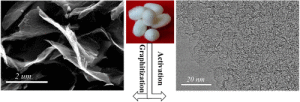
The integration of silk into the lithium-ion battery allowed the battery to work for over 10,000 cycles with only a nine percent loss in stability.
Image: ACS Nano
The words “lithium-ion” and “battery” have become almost synonymous recently. While the li-ion battery is used in a multitude of applications, it still does not have a long life without a recharge.
Now, researchers have developed an environmentally friendly way to boost the performance of the li-ion battery by focusing on a material derived from silk.
In the li-ion battery, carbon is the key component for storage. In most situations, graphite takes that role – but it has limited energy capacity. In order to improve the performance of the li-ion battery, researchers looked to replace graphite with a material developed using a sustainable source.
This from American Chemical Society:
The researchers found a way to process natural silk to create carbon-based nanosheets that could potentially be used in energy storage devices. Their material stores five times more lithium than graphite can — a capacity that is critical to improving battery performance. It also worked for over 10,000 cycles with only a 9 percent loss in stability. The researchers successfully incorporated their material in prototype batteries and supercapacitors in a one-step method that could easily be scaled up, the researchers note.
The research was published in the journal ACS Nano. Read it here.
If you’re looking to learn more about innovations in battery technology, make sure to attend the 227th ECS Meeting this May in Chicago!

